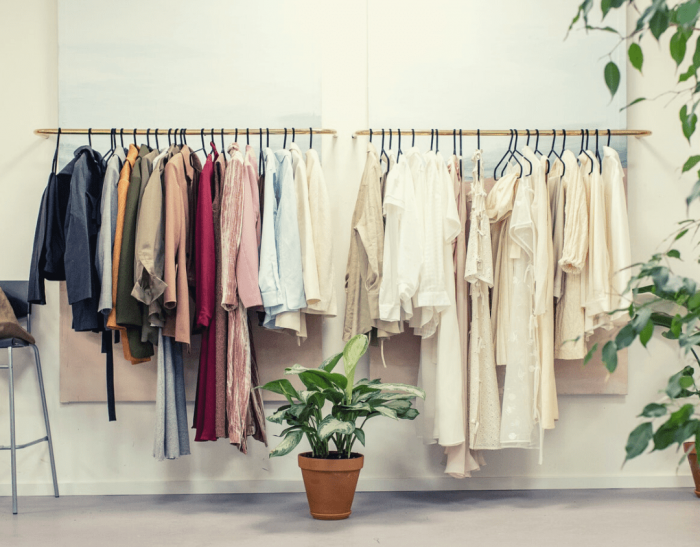When a report concluded that a planet-friendly wardrobe should have no more than 74 garments, three writers decided to conduct personal wardrobe audits, with surprising results.
It wasn't long into the process of auditing my wardrobe that I feared I would fail. Camisoles hanging under shirts; dresses hidden by jackets; crumpled jumpers fighting for drawer space. Halfway through, I'd already surpassed 74 garments. And that was before I remembered the suitcase in storage, containing my summer-only clothes.
A report published in 2022 by Berlin think tank Hot or Cool Institute suggests that a "sufficient" wardrobe consists of 74 garments and 20 outfits, with purchases of new garments limited to an average of five items per year. Based on the "conservative estimate" that 4% of global emissions come from fashion, the report's researchers said that the fashion industry would have to reduce its emissions to 1.1 billion tonnes of carbon dioxide equivalent (CO2e) in order to meet the Paris Agreement target of keeping global temperature rise below 1.5C. This equates to a roughly 50% reduction compared to the 2018 level of 2.1 billion tonnes, according to global consultancy McKinsey & Company.
The figures for what constitutes a sufficient wardrobe were worked out by analysing fashion's carbon footprint in the world's 20 richest countries and establishing a fair footprint target for each person.
As I looked through my wardrobe, my fear turned to shame. I checked in with fellow journalists Martha Henriques and Will Park, who were also carrying out a wardrobe audit. They, too, owned more clothes than the "sufficient" 74 items. And we were about to reveal our findings to Dilys Williams, director of the Centre for Sustainable Fashion at London College of Fashion, University of the Arts London, who had agreed to cast her expert eye over our clothing choices and make recommendations.
"My first thought is that it's a shame all three of you feel guilty and embarrassed – that's a harsh judgement on yourselves and the last thing the report should do," she says. "Instead, it should encourage us to ask: what kind of lifestyle am I part of? Why have I got this number of pieces in my wardrobe? Is it because the fashion system is selling an ideal that doesn't exist?"
For Williams, the report shines a light on a pervasive culture of newness, driven by trends and supported by cheap prices and easy returns.
"Businesses are not paying for the full price of what they're making," says Williams. "The accountancy model for fashion is flawed because it doesn't count the environmental and social costs – these are the societal costs we pay."
Ana's wardrobe
That's not to say we can't do anything about it. Despite the discomfort I felt over the size of my wardrobe, I'm proud of the change in my purchasing behaviour. In the last 12 months, I've only bought two items of clothing – 84% of my clothes were bought more than five years ago. But because I'm choosing from a collection based on decisions I made a long time ago, my clothes aren't always reflective of who I am today, so I tend to wear the same items on repeat, which isn’t much fun. According to the Waste and Resources Action Programme (Wrap), a British charity, about 30% of clothing in UK wardrobes has not been worn for at least a year.
"Getting dressed should be about being able to put on another skin, otherwise it's just functional," says Williams. "So, why aren't you wearing your clothes? Is it really because you no longer like them or because you're out of the habit of wearing certain pieces? Have you tried styling different items together? Or upcycling?"
I show Williams a skirt I'm particularly proud of. It had been hanging in my wardrobe unworn for 10 years until I took it to a local tailor to have the hem taken up, creating a completely new silhouette, from A-line to mini. It cost £25 ($31) to repair. I could have bought a new skirt for the same price from that fast fashion retailer today.
"That's where the economics of the situation is another barrier – it's much cheaper to buy something new than get it mended or changed," says Williams, who recommended to the UK government to remove VAT from repair, mirroring the policy in Sweden. "But that one act of you not buying something new from a fast fashion retailer is a subversion of that retailer. It's also a myth that every low price item of clothing will fall apart. A lot of the durability of something comes down to how we look after it."
We move on to knitwear, and I show Williams two jumpers: one is made from 100% traceable wool and I store it in a special bag that comes with a de-pilling comb, supplied by the retailer. It's my favourite jumper. The other is crumpled, pilled and tatty – a blend of polyester, viscose, cashmere and nylon.
"These mixed fibres won't biodegrade," says Williams. "This jumper – that isn't desirable, that doesn't make you feel good – is here forever."
The majority of our clothes are made from a blend of fibres. It's for this reason that only 1% of clothing is recycled – it's difficult to separate the fibres without degrading them, and thus create something new. What's more, polyester – the world's most commonly used fibre – is made from oil. In fact, synthetic materials like polyester make up 62% of all fibres, while wool accounts for just 1%.
"And yet wool is the most incredible fibre – it lasts longer and it's thermo-dynamic, meaning it keeps you warm in winter and cool in summer," says Williams, stroking my chunky wool jumper. (Read more about the debate on using wool for 'sustainable' fashion).
I tell Williams – reluctantly – that I've never washed this jumper and vouch for its lovely smell. I simply air it outside. "That's another cultural barrier," Williams laughs. "We think that once we've worn something we need to wash it, which is not true. Washing degrades a garment."
Fashion produces 20% of all waste water and it takes around 3,781 litres (832 gallons) of water to make one pair of jeans. I have 12 of them in my wardrobe. Most have lost their shape and the washes are unrecognisable from what I originally bought.
"Adding elastane into the cotton will make jeans less durable," Williams says, inspecting the care label. "There's a reason why Levi's 501s have transcended time. Do you actually need that stretch? Or could you wear a jean in?"
Martha's wardrobe
Jeans were not a consideration Martha had to make when auditing her wardrobe; her nemesis are leggings. "The question I ask myself most mornings is: 'Can I get away with wearing leggings?' 90% of the time, the answer is 'absolutely'," she says. "But I've not yet found a good source of second-hand leggings of the sufficiently thick, hard-wearing and well-fitting variety that I live in – so I buy a couple of new pairs each year as they wear out."
Even though Martha's leggings are made from "sustainable" viscose, to give them stretch they contain – like most – some elastane, a synthetic, fossil-fuel derived material. Recycled versions of these materials exist, but Williams warns that recycled synthetic fibres often come from a different supply chain – the plastics bottles industry, a worry echoed by the campaign group Changing Markets Foundation. Williams' advice is to prioritise longevity; to find brands whose leggings last. Avoiding seams and caring for the garments by making better washing choices also help to prolong their life.
A chart outlining the results of the wardrobe audit carried out by Ana Santi, Martha Henriques and Will Park (Credit: Javier Hirschfeld)
A chart outlining the results of the wardrobe audit carried out by Ana Santi, Martha Henriques and Will Park (Credit: Javier Hirschfeld)
What sets Martha's wardrobe apart is the percentage of clothes that were not bought new. A staggering 53% of her wardrobe is made up of second-hand or upcycled items, much higher than the average 9% in the US.
Still, second-hand clothing is expected to be a nearly $90bn (£73bn) market in the US in the next 10 years, growing faster than any other channel in the fashion sector. Globally, the apparel resale market will grow by 16% from $182bn (£147bn) between 2022 and 2026, according to a report by Global Data, driven by the proliferation of second-hand platforms such as Vinted and Depop.
"Some of my second-hand clothes are so well-loved I haven't been able to throw them away even after they were worn into holes," Martha says. "If I can conceal the holes by rolling up a sleeve or patching them up, I do. As I see it, the things you wear into holes are, by definition, the best clothes in your wardrobe."
Yet despite Martha's attachment to her considered purchases, she was surprised to discover many pieces she didn't know she owned – as much as 25%. Martha blames this on poor storage solutions. Williams asks her how she felt when she discovered them again.
"A lot of the old clothes I don't wear have sentimental value, so it was nice to rediscover them," Martha says. "Some of them I know I'm unlikely to wear again but can't bring myself to donate, but others I’m thinking of reviving. A few have gone to the charity shop."
Will's wardrobe
Will, by contrast, knows every single item in his wardrobe and wears 95% of it (the remaining 5% is made up of vintage football shirts, treasured items collected over the years). He attributes this to a simple wardrobe, with muted colour palettes of navy, grey and beige, and simple silhouettes.
And, Williams tells Will, "you obviously have a good level of scrutiny before you buy something". "Yes, you do own more garments than make a sufficient wardrobe, but you don't succumb to the stimulus like the average person. You have a much better price x wear = value ratio."
About a third of Will's wardrobe is made up of sportswear, which tends to be made of nylon and polyester blends. "My suspicion is that these items will not score well in terms of environmental impact," he concedes. "Most of the tops and shorts I wear for the gym are manufactured many miles from here. They are also washed after every use, usually at 40C (104F)."
He's right. Washing synthetic fibres releases microplastics, which pollute our waterways. Textiles are the largest source of primary microplastics, accounting for 34.8% of global microplastic pollution. Research from Leeds University in the UK found that reducing both washing cycle length and water temperature can significantly extend the life of garments and reduce the quantity of dye and microfibres shed into the environment.
However, Williams suggests also looking beyond materials to the practices of sportswear brands and, in particular, checking out signatories of the United Nations' Fashion Industry Charter for Climate Action. The charter commits signatories to keeping within 1.5C, with initiatives such as swapping to renewable energy to power factories.
Will's sportswear wardrobe includes skiwear, which he only wears once a year. It's an area ripe for the rental market, says Williams. Will could rent out his ski gear for most of the year, keeping the items in use and making some extra money on the side. EcoSki is one specialist skiwear rental platform in the UK, although many fashion platforms also offer the category. The danger is that, through regular use, the items may not last as long, but the growing professionalism of the rental market to include things like insurance encourages renters to look after and prolong the life of garments.
How to create a sufficient wardrobe
At the start of our wardrobe audits, the three of us had one key trait in common: we all owned more clothes than were deemed "sufficient" by the Hot or Cool Institute. We now have another: despite the report's allowance of five new items per year, none of us feels the urge to buy that much. Personally, I'll be investing in new swimwear – mine has lost its shape (and I'm a regular swimmer) – but that's it. Martha will continue to buy leggings, but look into alternatives.
"Honestly, I don't feel I need anything," says Will. "My flip-flops have seen better days, but it doesn't feel urgent. The football team I support has released a really nice new shirt, and in my defence I haven't bought a new one since 2013. But after the audit I am struggling to justify purchasing one."
So is there a formula for auditing a wardrobe, for making better clothing choices? While there is "no silver bullet", Williams suggests splitting your existing wardrobe into two categories: investment and cost. "For items that you love and wear, that you feel good about, that reflect your identity and values – they're an investment," she explains. "The garments whose provenance you're unsure of, that make you feel uncomfortable, that hang unworn in your wardrobe – these are a cost."
But with more than 100 billion items of new clothing produced each year – and 65% of these end up in landfill within 12 months – any action we take to avoid buying new clothing will help solve fashion's biggest problem: overproduction. By making adjustments to our wardrobes and own consumption, we will send a message to government and businesses – and change the system. As Williams says: "Collectively, as citizens, we have a lot of power."
More about:
















































